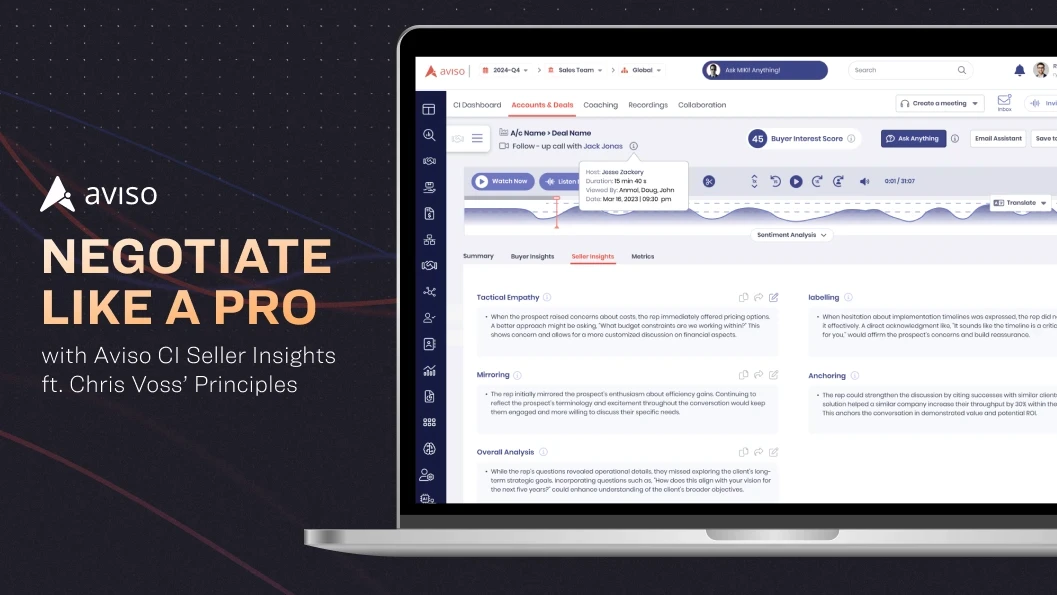Ace MEDDPICC Adherence With Aviso’s Conversation Intelligence
Aug 29, 2023
Sales methodologies are the backbone of any successful selling strategy. They provide a systematic approach to navigating the complex world of sales, allowing teams to streamline their processes and improve their close rates. Of the many sales methodologies utilized in the B2B space, MEDDPICC has emerged as a particularly effective one. It aids sales teams in better understanding their prospects, thereby increasing the chances of closing deals.
No matter how effective a sales methodology is, it all comes down to how consistently sales professionals are adhering to it.
But the truth is adherence to sales methodologies is very low. Why is that the case? What are the challenges in adhering to sales methodologies? How can they be overcome?
Before we get into that, for all novice sales enthusiasts, it's essential to first grasp the intricacies of the MEDDPICC sales methodology itself.
What is the MEDDPICC Sales Methodology
MEDDPICC stands for Metrics, Economic Buyer, Decision Criteria, Decision Process, Paper Process, Identify Pain, Champion, and Competition. Each of these aspects represents a critical step in the sales journey, from understanding the buyer's problems to finally closing the deal.
Let's take a deeper look into each component:
Metrics: Focuses on the economic impact of your solution.
Economic Buyer: Identifies the key decision-maker in the purchasing process.
Decision Criteria: Highlights the technical, vendor, and financial checklist the buyer uses to make a decision.
Decision Process: Understands the buyer's decision-making process from start to finish.
Paper Process: Identifies what needs to be done to go from decision to signed contract.
Identify Pain: Recognizes the buyer's pain points that your product or service can resolve.
Champion: Finds an advocate within the buyer's organization who can promote your solution.
Competition: Understands who the competitors are in the deal and how your solution differentiates from theirs
The Edge of MEDDPICC Over Other Methodologies
Sales methodologies are basically blueprints that guide salespeople through every stage of the sales process. They vary based on a number of factors, such as the sales environment, buyer persona, and the nature of the product or service being sold.
Unlike other methodologies that often focus only on the beginning or end of the sales process, MEDDPICC encompasses the entire sales cycle. It provides a comprehensive structure to help sales teams navigate the complex B2B buying landscape.
When adhered to strictly, it can bring about transformational changes in the sales organization's effectiveness. It allows for:
Strategic Prospecting: By identifying key decision-makers and their pain points early, sales teams can concentrate their efforts where they are most likely to succeed.
Better Forecast Accuracy: Since MEDDPICC emphasizes quantifying the economic benefit for the customer, sales forecasts become more accurate and reliable.
Increased Win Rates: By understanding the decision-making criteria and process, the sales team can tailor their pitches to the customer's needs, thus increasing the chances of securing the deal.
Challenges in adhering to MEDDPICC Sales Methodology
Sales professionals often encounter several challenges when adhering to a sales methodology like MEDDPICC. Here are the top three challenges they may face:
Gathering Information: Collecting accurate and comprehensive information for each element of MEDDPICC can be a challenge. Gathering data about metrics, decision criteria, pain points, and other factors requires thorough research and effective communication with potential clients. Incomplete or inaccurate information can lead to misaligned strategies and missed opportunities.
Balancing customization and standardization: Adhering to a structured methodology like MEDDPICC while tailoring it to individual prospects' needs can be a delicate balance. Sales professionals must ensure that they follow the methodology's framework while adapting it to specific situations, industries, and client requirements to maintain relevance and effectiveness.
Consistent Implementation across teams: Ensuring consistent implementation of MEDDPICC across the entire sales team can be a challenge. Different team members might interpret and apply the methodology differently, leading to inconsistent practices and outcomes. Ongoing training, communication, and monitoring are necessary to maintain alignment and maximize its benefits.
Leveraging Aviso’s Conversation Intelligence to Enhance MEDDPICC
In today's market, many CRM and Conversation Intelligence tools are primarily designed to offer fields for MEDDPICC updates. However, they often fall short of accurately capturing MEDDPICC-related information. As a result, sales representatives resort to manually updating these tools from their personal meeting notes, leading to inconsistent adherence to the MEDDPICC methodology among sales teams.
This is where Aviso's Conversation Intelligence stands out. It empowers sales professionals to strike the perfect balance between gathering MEDDPICC information and maintaining a seamless dialogue with the buyer. Purposefully engineered, Aviso's Conversation Intelligence detects keywords, phrases, and both verbal & non-verbal cues essential for accurate MEDDPICC data collection. In doing so, it promotes consistent adherence to the MEDDPICC sales methodology across various sales teams.
Here's a detailed breakdown of how each element of MEDDPICC is efficiently tracked by Aviso's Conversation Intelligence:
Metrics: Gaining a profound understanding of the vital metrics and KPIs that drive the buyer's success.
Call Transcript: Pinpoint words like "revenue" and "ROI," phrases such as "increase revenue by," and questions delving into the buyer's metrics. Extract sentences where the seller aligns their solution to the buyer's metric ambitions.
Non-Verbal Cues: On audio, a buoyant tone when discussing buyer metrics signals alignment. Video cues, like nodding in agreement, further indicate this alignment.
Economic Buyer: Identifying those with purchasing authority based on the economic consequences of the solution.
Call Transcript: Extract references to key decision-makers, phrases like "the CFO," and questions aiming to pinpoint the economic buyer.
Non-Verbal Cues: A tone of respect on audio, or signs of deference like sitting up straight on video, can reveal the seller's awareness of the economic buyer's significance.
Decision Criteria: Decoding the factors pivotal to the buyer's choice.
Call Transcript: Capture words like "features" and "integration" or phrases such as "our decision hinges on." Understand the buyer's priorities through their questions and relevant sentences.
Non-Verbal Cues: Indicators of attentiveness on both audio (engaged tone) and video (leaning in) showcase the seller's genuine interest in the buyer's criteria.
Decision Process: Grasping the buyer's decision-making stages and involved parties.
Call Transcript: Identify words related to the decision stages, phrases describing the buyer's current phase, and questions about the stakeholder roles.
Non-Verbal Cues: A collaborative tone on audio and open body language on video suggest a seller's adaptability to the buyer's procedures.
Paper Process: Comprehending the buyer's internal protocol for finalizing a purchase.
Call Transcript: Look for words like "contract" or "legal review" and questions probing the specific documentation needs.
Non-Verbal Cues: A reassuring tone in audio, or confidence showcased on video, indicates the seller's commitment to meeting internal requirements.
Implications: Assessing the broader impact and potential fallout of the buyer's challenges.
Call Transcript: Extract words such as "risk" or "opportunity cost" and sentences underlining the seller's grasp of the problem's implications.
Non-Verbal Cues: On audio, a serious tone hints at the seller's genuine concern, whereas empathy is discerned on video through facial expressions.
Champion: Spotting a staunch advocate within the buyer's organization.
Call Transcript: Identify words like "champion" and phrases showcasing the presence of an advocate. Understand the seller's relationship with this advocate through their sentences and questions.
Non-Verbal Cues: An enthusiastic tone in audio or excited facial expressions on video emphasizes the seller's positive rapport with the champion.
Competition: Recognizing the competitors in the buyer's consideration set.
Call Transcript: Pinpoint mentions of competitors, phrases detailing the competitive scenario, and questions about the buyer's comparative evaluations.
Non-Verbal Cues: A confident audio tone or determined facial expressions on video convey the seller's readiness to stand out in the competitive landscape.
Conclusion
As the B2B landscape evolves, the integration of conversation intelligence and sales methodologies like MEDDPICC will become increasingly significant. Aviso’s Conversation Intelligence can exponentially drive adherence to the MEDDPICC sales methodology, enabling sellers to qualify prospects more effectively, predict outcomes more accurately, and, ultimately, close more deals.
Embracing this union not only streamlines your sales process but also improves the predictability of your sales outcomes, making it a win-win situation for both sellers and buyers.
It allows them to navigate the intricate B2B SaaS sales landscape effectively, leading to higher conversion rates and stronger customer relationships.
Discover how Aviso AI can revolutionize your B2B sales journey; book a demo today to experience the transformation firsthand.







